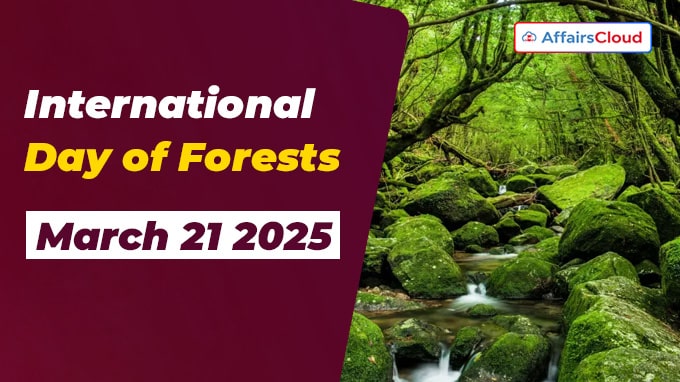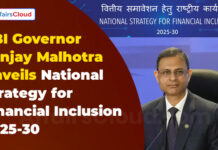 The United Nations (UN’s) International Day of Forests (IDF) is observed annually across the globe on March 21 to celebrate all kinds of forests, emphasize the significance of trees and forests, and encourage efforts to safeguard them.
The United Nations (UN’s) International Day of Forests (IDF) is observed annually across the globe on March 21 to celebrate all kinds of forests, emphasize the significance of trees and forests, and encourage efforts to safeguard them.
- The theme for IDF 2025 is “Forest and Foods,” highlighting the essential role forests play in food security, nutrition, and livelihoods.
- The theme for each IDF is selected by the Collaborative Partnership on Forests.
Background:
i.On December 21, 2012, the UN General Assembly (UNGA) adopted resolution A/RES/67/200, proclaiming March 21 as the International Day of Forests.
ii.The first IDF was celebrated on March 21, 2013.
iii.IDF is organized annually by the UN Forum on Forests (UNFF) and the UN’s Food and Agriculture Organization (FAO), in collaboration with other partners.
Significance of Forests:
i.Forests are vital for the planet’s survival, providing oxygen, food, medicine, and livelihoods to millions.
ii.Support food security, biodiversity, and climate change mitigation by storing carbon.
iii.Enhance soil fertility, protect water resources, and provide economic benefits through income and job opportunities for local communities.
About Transforming Forest Finance Report:
A report titled “Transforming Forest Finance,” released ahead of the International Day of Forests(on March 21), by the Forest Declaration Assessment, supported by the United Nations Development Programme (UNDP) and the Climate and Land Use Alliance, highlights the inadequate financial support for forest conservation.
Key findings include:
i.An estimated USD 460 billion annually is required to stop deforestation, but current funding falls short. Developing countries are facing a massive debt burden, which totals USD 11 trillion.
- For every USD 1 spent on forest protection, USD 6 is invested in industries like industrial agriculture and logging, which contribute to deforestation.
ii.In 2023, private financial institutions directed USD 6.1 trillion into sectors connected to deforestation, while governments contributed USD 500 billion through subsidies that had negative environmental impacts.
iii.The REDD+ (Reducing Emissions from Deforestation and Forest Degradation) is a climate change mitigation solution developed by Parties to the United Nations Framework Convention on Climate Change (UNFCCC).
- The REDD+ programme has been criticized for offering insufficient compensation. Current payment rates vary between USD 5 and USD 10 per tonne of Carbon(C), while the actual cost of reducing emissions is believed to range from USD 30 to USD 50 per tonne.
Note: REDD+ is also known as the Warsaw Framework for REDD+ (WFR) adopted at 19th session of the Conference of the Parties(COP 19) in Warsaw(Poland) in 2013.
iv.The report outlines six key actions to address the forest finance crisis: Reform Public and Multilateral Finance; Overhaul Sovereign Debt Systems; Redirect Harmful Subsidies; Increase Direct Funding to Local and Indigenous Communities; Strengthen Financial Regulations; and Advocate for Innovative Financing Models.
India’s Initiatives for Forest Conservation:
The Ministry of Environment, Forest and Climate Change (MoEFCC), Government of India (GoI), has launched several schemes linking forests to food security, nutrition, and livelihoods:
1.National Agroforestry Policy (2014):
- Promotes agroforestry to integrate trees with crops, enhancing productivity and income for farmers.
- Nodal Agency: Indian Council of Agricultural Research (ICAR)-Central Agroforestry Research Institute (CAFRI) in Jhansi, Uttar Pradesh (UP) provides technical support and training.
Note: Agroforestry is a sustainable land-use system that combines trees and crops to boost productivity, improve soil, and provide extra income for farmers.
2.Green India Mission (GIM):
- GIM also known as National Mission for a Green India, is a key part of India’s National Action Plan on Climate Change (NAPCC).
- Aims to increase forest cover by 5 million hectares (mha) and improve the quality of another 5 mha of forest and non-forest land.
- The Ecosystem Services Improvement Project (ESIP), backed by the World Bank (WB), is operational in Chhattisgarh and Madhya Pradesh (MP) of India.
- As of July 2024, Rs. 909.82 crores have been allocated to 17 states and 1 Union Territory (UT) of India for plantation and eco-restoration over 155,130 ha.
3.Forest Fire Prevention & Management Scheme:
- A Centrally Sponsored Scheme to prevent and control forest fires.
- The Forest Survey of India (FSI), Dehradun (Uttarakhand), manages a satellite-based Forest Fire Monitoring and Alert System, sending fire alerts via Short Message Service (SMS) and electronic mail (e-mail).
4.Pradhan Mantri Van Dhan Yojana (PMVDY) (2018):
- Launched by the Ministry of Tribal Affairs (MoTA) and TRIFED (Tribal Cooperative Marketing Development Federation of India) in 2018
- Aims to improve tribal livelihoods by enhancing the value of forest produce.
- Tribal communities form Van Dhan Vikas Kendras (VDVKs) with 300 members to process and market Minor Forest Produce (MFPs).
- Each VDVK receives Rs.15 lakh, with tribal members contributing Rs.1,000 each.
Key Points:
i..According to the India State of Forest Report (ISFR) 2023, India’s forest and tree cover increased by 25.17%, with 21.76% being forest cover of 7.15 lakh square kilometer (sq. km) and 3.41% tree cover (1,289 sq. km).
ii.The top three states with the largest forest and tree cover are: Madhya Pradesh (MP)– 85,724 sq km, Arunachal Pradesh (AR)– 67,083 sq km, Maharashtra – 65,383 sq km
iii.The top three states with the largest forest cover are: MP– 77,073 sq km, AR – 65,882 sq km, Chhattisgarh – 55,812 sq km.




